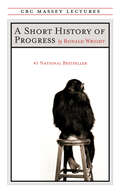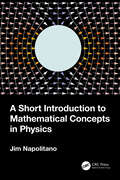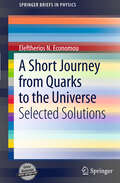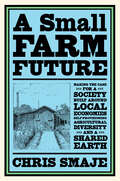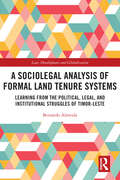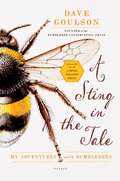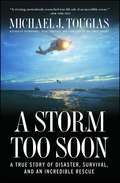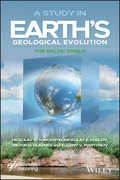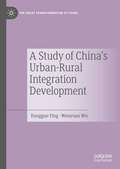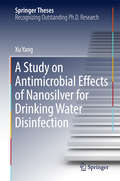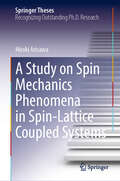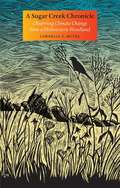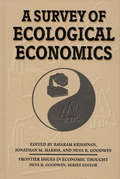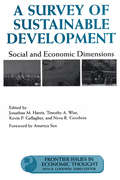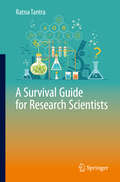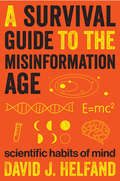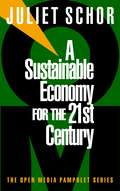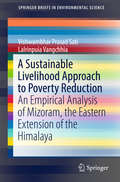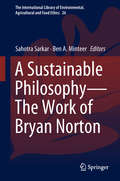- Table View
- List View
A Short History of Geomorphology (Routledge Library Editions: Geology #26)
by Keith J. TinklerThis book, first published in 1985, is a comprehensive guide to the main ideas in the history of geomorphology. It traces the development of thinking on landforms, with material ranging from the ancient world to the present day. The main areas covered are the Renaissance, the explosive growth of the Natural Sciences in the nineteenth century and the impact of the Second World War. The papers and theories of specialists like James Hutton, John Playfair and W.M. Davies are presented and discussed and the final chapters reflect on future change, based on the past and speculation on possible developments. Balance is maintained between the dual importance and dominance of English and North American contributions to the subject, and quite substantial research was undertaken to provide a more complete approach to some areas hitherto neglected.
A Short History of Progress: Fifteenth Anniversary Edition (The CBC Massey Lectures)
by Ronald WrightNow more relevant than ever, Ronald Wright’s #1 national bestseller, A Short History of Progress. The fifteenth anniversary edition includes a new introduction warning of the accelerating patterns of progress and disaster.Each time history repeats itself, so it’s said, the price goes up. The twentieth century was a time of runaway growth in human population, consumption, and technology, placing a colossal load on all natural systems, especially earth, air, and water — the very elements of life. The most urgent questions of the twenty-first century are: Where will this growth lead? Can it be consolidated or sustained? And what kind of world is our present bequeathing to our future?In his #1 national bestseller A Short History of Progress Ronald Wright argues that our modern predicament is as old as civilization, a 10,000-year experiment we have participated in but seldom controlled. Only by understanding the patterns of triumph and disaster that humanity has repeated around the world since the Stone Age can we recognize the experiment’s inherent dangers, and, with luck and wisdom, shape its outcome. In his new introduction to the fifteenth anniversary edition, Wright looks at the past fifteen years of human innovation — and asks whether we can still get the future right.
A Short Introduction to Climate Change
by Tony EggletonA Short Introduction to Climate Change provides a clear, balanced and well documented account of one of the most important issues of our time. It covers developments in climate science over the past 250 years and shows that recent climate change is more than the result of natural variability. It explains the difference between weather and climate by examining changes in temperature, rainfall, Arctic ice and ocean currents. It also considers the consequences of our use of fossil fuels and discusses some of the ways to reduce further global warming. Tony Eggleton avoids the use of scientific jargon to provide a reader-friendly explanation of the science of climate change. Concise but comprehensive, and richly illustrated with a wealth of full-colour figures and photographs, A Short Introduction to Climate Change is essential reading for anyone who has an interest in climate science and in the future of our planet.
A Short Introduction to Mathematical Concepts in Physics
by Jim NapolitanoMathematics is the language of physics and yet, mathematics is an enormous subject. This textbook provides an accessible and concise introduction to mathematical physics for undergraduate students taking a one semester course. It assumes the reader has studied a year of introductory physics and three semesters of basic calculus, including some vector calculus, but no formal training in differential equations or matrix algebra. It equips readers with the skills and foundational knowledge they need for courses that follow in classical mechanics, electromagnetism, quantum mechanics, and thermal physics. This book exposes students early on to the kinds of mathematical manipulations they will need in upper-level courses in physics. It can also serve as a useful reference for their further studies. Key features: Accompanied by homework problems and a solutions manual for instructors, available upon qualifying course adoption Bridges the gap between calculus and physics, explaining fundamental mathematics (differentiation, integration, infinite series) in physical terms Explores quick extensions into mathematics useful in physics, not typically taught in math courses, including the Gamma Function, hyperbolic functions, Gaussian integrals, Legendre polynomials, functions of a complex variable, and probability distribution functions
A Short Journey from Quarks to the Universe (SpringerBriefs in Physics)
by Eleftherios N. EconomouThis book takes the reader for a short journey over the structures of matter showing that their main properties can be obtained even at a quantitative level with a minimum background knowledge. The latter, besides some high school physics and mathematics, consists of the three cornerstones of science presented in chapters 1 to 3, namely the atomic idea, the wave-particle duality, and the minimization of energy as the condition for equilibrium. Dimensional analysis employing the universal constants and combined with "a little imagination and thinking", to quote Feynman, allows an amazing short-cut derivation of several quantitative results concerning the structures of matter. This book is expected to be of interest to physics, engineering, and other science students and to researchers in physics, material science, chemistry, and engineering who may find stimulating the alternative derivation of several real world results, which sometimes seem to pop out the magician's hat.
A Small Farm Future: Making the Case for a Society Built Around Local Economies, Self-Provisioning, Agricultural Diversity and a Shared Earth
by Chris SmajeIn a time of looming uncertainties, what would a truly resilient society look like? In a groundbreaking debut, farmer and social scientist Chris Smaje argues that organising society around small-scale farming offers the soundest, sanest and most reasonable response to climate change and other crises of civilisation—and will yield humanity’s best chance at survival. Drawing on a vast range of sources from across a multitude of disciplines, A Small Farm Future analyses the complex forces that make societal change inevitable; explains how low-carbon, locally self-reliant agrarian communities can empower us to successfully confront these changes head on; and explores the pathways for delivering this vision politically. Challenging both conventional wisdom and utopian blueprints, A Small Farm Future offers rigorous original analysis of wicked problems and hidden opportunities in a way that illuminates the path toward functional local economies, effective self-provisioning, agricultural diversity and a shared earth.
A Sociolegal Analysis of Formal Land Tenure Systems: Learning from the Political, Legal and Institutional Struggles of Timor-Leste (Law, Development and Globalization)
by Bernardo Ribeiro AlmeidaThis sociolegal study focuses on the political, legal and institutional problems and dilemmas of regulating land tenure. By studying the development of the Timorese formal land tenure system, this book engages in the larger debate about the role of state systems in addressing and aggravating social problems such as insecurity, poverty, inequality, destruction of nature, and cultural and social estrangement. Land tenure issues in Timor-Leste are complex and deeply shaped by the nation’s history. Taking an insider’s perspective based on the author’s experience in Timorese state administration, and through the investigation of five analytical themes –political environment, lawmaking, legal framework, institutional framework, and social relationships and practices– this book studies the development of the Timorese formal land tenure system from independence in 2002 to 2018. It shows how political, legal, and administrative decisions on land administration are made, what and who influences them, which problems and dilemmas emerge, and how the formal system works in practice. The result is a portrait of a young nation grappling with the enormous task of creating a land tenure system that can address the needs of its citizens in the wake of centuries of socio-political tumult and huge fluctuations in resources. The book concludes by highlighting the importance of lawmaking and how abuses of power can be curbed by adequate administrative processes and laws. Finally, it argues that land administration is primarily a political matter. The political dimension of technical solutions must be considered if we aim to achieve fairer formal land tenure systems. The pertinence of the topics covered, the multi-disciplinary perspective, and the research methodology followed make this book appealing to a variety of readers, including international organizations, practitioners, academics and students engaged in land administration, post-colonial and -conflict issues, lawmaking, rule of law, public administration and issues of access and exclusion.
A Statistical Mechanical Interpretation of Algorithmic Information Theory (SpringerBriefs in Mathematical Physics #36)
by Kohtaro TadakiThis book is the first one that provides a solid bridge between algorithmic information theory and statistical mechanics. Algorithmic information theory (AIT) is a theory of program size and recently is also known as algorithmic randomness. AIT provides a framework for characterizing the notion of randomness for an individual object and for studying it closely and comprehensively. In this book, a statistical mechanical interpretation of AIT is introduced while explaining the basic notions and results of AIT to the reader who has an acquaintance with an elementary theory of computation.A simplification of the setting of AIT is the noiseless source coding in information theory. First, in the book, a statistical mechanical interpretation of the noiseless source coding scheme is introduced. It can be seen that the notions in statistical mechanics such as entropy, temperature, and thermal equilibrium are translated into the context of noiseless source coding in a natural manner. Then, the framework of AIT is introduced. On this basis, the introduction of a statistical mechanical interpretation of AIT is begun. Namely, the notion of thermodynamic quantities, such as free energy, energy, and entropy, is introduced into AIT. In the interpretation, the temperature is shown to be equal to the partial randomness of the values of all these thermodynamic quantities, where the notion of partial randomness is a stronger representation of the compression rate measured by means of program-size complexity. Additionally, it is demonstrated that this situation holds for the temperature itself as a thermodynamic quantity. That is, for each of all the thermodynamic quantities above, the computability of its value at temperature T gives a sufficient condition for T to be a fixed point on partial randomness.In this groundbreaking book, the current status of the interpretation from both mathematical and physical points of view is reported. For example, a total statistical mechanical interpretation of AIT that actualizes a perfect correspondence to normal statistical mechanics can be developed by identifying a microcanonical ensemble in the framework of AIT. As a result, the statistical mechanical meaning of the thermodynamic quantities of AIT is clarified. In the book, the close relationship of the interpretation to Landauer's principle is pointed out.
A Sting In The Tale: My Adventures With Bumblebees
by Dave GoulsonDave Goulson became obsessed with wildlife as a small boy growing up in rural Shropshire, starting with an increasingly exotic menagerie of pets. When his interest turned to the anatomical, there were even some ill-fated experiments with taxidermy. But bees are where Goulson's true passion lies—the humble bumblebee in particular. <p><p> Once commonly found in the marshes of Kent, the English short-haired bumblebee went extinct in the United Kingdom, but by a twist of fate still exists in the wilds of New Zealand, the descendants of a few pairs shipped over in the nineteenth century. Dave Goulson's passionate quest to reintroduce it to its native land is one of the highlights of a book that includes original research into the habits of these mysterious creatures, history's relationship with the bumblebee, and advice on how to protect the bumblebee for future generations. <p> One of the United Kingdom's most respected conservationists and the founder of the Bumblebee Conservation Trust, Goulson combines lighthearted tales of a child's growing passion for nature with a deep insight into the crucial importance of the bumblebee. He details the minutiae of life in the nest, sharing fascinating research into the effects intensive farming has had on our bee population and the potential dangers if we are to continue down this path.
A Storm Too Soon
by Michael J. TougiasFROM MASTERFUL STORYTELLER MICHAEL J. TOUGIAS COMES A NEW, HEART-STOPPING TRUE-LIFE TALE OF MARITIME DISASTER, SURVIVAL, AND DARING RESCUE, HIS MOST THRILLING AND AMAZING STORY YET. Seventy-foot waves batter a torn life raft 250 miles out to sea in one of the world's most dangerous places, the Gulf Stream. Hanging on to the raft are three men, a Canadian, a Brit, and their captain, JP de Lutz, a dual citizen of America and France. Their capsized forty-seven-foot sailboat has filled with water and disappeared below the tempestuous sea. The giant waves repeatedly toss the men out of their tiny vessel, and JP, with nine broken ribs, is hypothermic and on the verge of death. The captain, however, is a remarkably tough character, having survived a brutal boyhood, and now he must rely on the same inner strength to outlast the storm. Trying to reach these survivors before it's too late are four brave Coast Guardsmen battling hurricane- force winds in their Jayhawk helicopter. They know the waves will be extreme, but when they arrive they are astounded to find that the monstrous seas have waves reaching eighty feet. Lowering the wind-whipped helicopter to drop a rescue swimmer into such chaos will be extremely dangerous. The pilots wonder if they have a realistic chance of saving the sailors clinging to the broken life raft, and if they will be able to even retrieve their own rescue swimmer from the towering seas. Once they commit to the rescue, they find themselves in almost as much trouble as the survivors, facing one life-and-death moment after the next. Also caught in the storm are three other boats, each one in a Mayday situation. Of the ten people on these boats, only six will ever see land again. Spellbinding, harrowing, and meticulously researched, A Storm Too Soon is a vivid account about the powerful collision between the forces of nature and the human will to survive. Author Michael J. Tougias, known for his fast-paced writing style and character-driven stories, tells this true saga in the present tense to give the reader a thrilling, edge-of-your-seat immediacy. A Storm Too Soon is Tougias at his masterful best and a heart-pounding narrative of survival, the power of the human spirit, and one of the most incredible rescues ever attempted.
A Storm Too Soon: A True Story of Disaster, Survival and an Incredib
by Michael J. TougiasFROM MASTERFUL STORYTELLER MICHAEL J. TOUGIAS COMES A NEW, HEART-STOPPING TRUE-LIFE TALE OF MARITIME DISASTER, SURVIVAL, AND DARING RESCUE, HIS MOST THRILLING AND AMAZING STORY YET. Seventy-foot waves batter a torn life raft 250 miles out to sea in one of the world's most dangerous places, the Gulf Stream. Hanging on to the raft are three men, a Canadian, a Brit, and their captain, JP de Lutz, a dual citizen of America and France. Their capsized forty-seven-foot sailboat has filled with water and disappeared below the tempestuous sea. The giant waves repeatedly toss the men out of their tiny vessel, and JP, with nine broken ribs, is hypothermic and on the verge of death. The captain, however, is a remarkably tough character, having survived a brutal boyhood, and now he must rely on the same inner strength to outlast the storm. Trying to reach these survivors before it's too late are four brave Coast Guardsmen battling hurricane- force winds in their Jayhawk helicopter. They know the waves will be extreme, but when they arrive they are astounded to find that the monstrous seas have waves reaching eighty feet. Lowering the wind-whipped helicopter to drop a rescue swimmer into such chaos will be extremely dangerous. The pilots wonder if they have a realistic chance of saving the sailors clinging to the broken life raft, and if they will be able to even retrieve their own rescue swimmer from the towering seas. Once they commit to the rescue, they find themselves in almost as much trouble as the survivors, facing one life-and-death moment after the next. Also caught in the storm are three other boats, each one in a Mayday situation. Of the ten people on these boats, only six will ever see land again. Spellbinding, harrowing, and meticulously researched, A Storm Too Soon is a vivid account about the powerful collision between the forces of nature and the human will to survive. Author Michael J. Tougias, known for his fast-paced writing style and character-driven stories, tells this true saga in the present tense to give the reader a thrilling, edge-of-your-seat immediacy. A Storm Too Soon is Tougias at his masterful best and a heart-pounding narrative of survival, the power of the human spirit, and one of the most incredible rescues ever attempted.
A Student's Guide to Geophysical Equations
by William LowrieThe advent of accessible student computing packages has meant that geophysics students can now easily manipulate datasets and gain first-hand modeling experience - essential in developing an intuitive understanding of the physics of the Earth. Yet to gain a more in-depth understanding of physical theory, and to develop new models and solutions, it is necessary to be able to derive the relevant equations from first principles. This compact, handy book fills a gap left by most modern geophysics textbooks, which generally do not have space to derive all of the important formulae, showing the intermediate steps. This guide presents full derivations for the classical equations of gravitation, gravity, tides, earth rotation, heat, geomagnetism and foundational seismology, illustrated with simple schematic diagrams. It supports students through the successive steps and explains the logical sequence of a derivation - facilitating self-study and helping students to tackle homework exercises and prepare for exams.
A Study in Earth's Geological Evolution: The Baltic Shield
by Nikolay O. Sorokhtin Nikolay E. Kozlov Viktor N. Glaznev Eugeny V. MartynovLike N. O. Sorokhtin’s most recent book, The Origins of Natural Diamonds, also available from Wiley-Scrivener at www.wiley.com, this is not just the story of the origin and evolution of the Baltic Shield, but a story about the evolution of the Earth’s geology in general. Important to geologists, geophysicists, and engineers across multiple disciplines, written by an expert in the field and an expert on the Earth’s geological evolution, this volume represents the state-of-the-art in major Earth geological processes. Of particular importance to mining engineers and petroleum engineers, it is also a practical guide for those who work in the mining or petroleum industry. Before presenting the most in-depth discussion of the Baltic Shield available and its implications for study by geologists and various industries such as the petroleum industry, the author presents a theory for how the Earth, as we know it, came into existence and developed. He bases this theory on scientific evidence and mathematical models, using this as a basis for further explanation of the Earth’s geological evolution. Valuable as either a learning tool for the student or as a reference or refresher for the veteran scientist or engineer, the author explains important geological processes, such as the Earth’s origin, composition, and structure, the Earth’s energy balance, continental drift, tectonic activity, the evolution of the Earth’s crust, and others. It is within this geological framework that the author offers practical guidance for engineers and scientists who work in industry or academia. It is a must-have for any geologist, geophysicist, or engineer working in mining or petroleum engineering.
A Study of China's Urban-Rural Integration Development (The Great Transformation of China)
by Wenyuan Wu Dangguo YingChina's urbanization has stunned the world in the past two decades- but as the authors of this book explain, the growth is only set to continue. The divide between urban and rural citizens in China implicates every aspect of Chinese life, from education to pollution to healthcare. In this book, one of China's most celebrated academic urbanists and a major urban planner collaborate in laying out and analyzing the problems of China's urban-rural divide, experiences of urbanization, and what the future holds. This book is a must read, not only for the accurate summaries of China's developmental experience it includes, but also for the insights it provides into the mentalities of the government officials and private developers who are creating realities on the ground in Chinese cities.
A Study on Antimicrobial Effects of Nanosilver for Drinking Water Disinfection (Springer Theses)
by Xu YangThis thesis examines the feasibility of using silver nanoparticles (AgNPs) as a viable disinfectant. It explores the opportunities and challenges of using AgNPs as an antimicrobial agent, and includes the latest research findings. It compares three kinds of AgNPs with regard to their antibacterial and antiviral effects; their sustainability in real water matrices; and their antiviral mechanisms. The outcome of this research equips the water industry with a better understanding of the capacity, extent and mechanisms of nanosilver disinfection. It is of interest to graduate students, academics and researchers in the area of nanotechnology and environmental engineering.
A Study on Spin Mechanics Phenomena in Spin-Lattice Coupled Systems (Springer Theses)
by Hiroki ArisawaThis book presents an experimental investigation of spin-mechanical phenomena in spin-lattice coupled systems. The author demonstrates that the resonant mechanical vibration of a micro magnetic mechanical oscillator changes in response to the magnetization process in the oscillator. The author also investigates a spin-current-induced volume modulation effect in a giant magnetostrictive material. The results presented here accelerate the exploration of cross-correlation effects between spintronics and micromechanics and provide insight into magnetomechanical properties associated with a spin current.
A Sugar Creek Chronicle: Observing Climate Change from a Midwestern Woodland
by Cornelia F. MutelIn 2010, while editing a report on the effects of climate change in Iowa, ecologist Cornelia Mutel came to grips with the magnitude and urgency of the problem. She already knew the basics: greenhouse gas emissions and global average temperatures are rising on a trajectory that could, within decades, propel us beyond far-reaching, irreversible atmospheric changes; the results could devastate the environment that enables humans to thrive. The more details she learned, the more she felt compelled to address this emerging crisis. The result is this book, an artful weaving together of the science behind rising temperatures, tumultuous weather events, and a lifetime devoted to the natural world. Climate change isn't just about melting Arctic ice and starving polar bears. It's weakening the web of life in our own backyards. Moving between two timelines, Mutel pairs chapters about a single year in her Iowa woodland with chapters about her life as a fledgling and then professional student of nature. Stories of her childhood ramblings in Wisconsin and the solace she found in the Colorado mountains during early adulthood are merged with accounts of global environmental dilemmas that have redefined nature during her lifespan. Interwoven chapters bring us into her woodland home to watch nature's cycles of life during a single year, 2012, when weather records were broken time and time again. Throughout, in a straightforward manner for a concerned general audience, Mutel integrates information about the science of climate change and its dramatic alteration of the planet in ways that clarify its broad reach, profound impact, and seemingly relentless pace. It is not too late, she informs us: we can still prevent the most catastrophic changes. We can preserve a world full of biodiversity, one that supports human lives as well as those of our myriad companions on this planet. In the end, Mutel offers advice about steps we can all take to curb our own carbon emissions and strategies we can suggest to our policy-makers.
A Survey of Ecological Economics (Frontier Issues in Economic Thought #1)
by Jonathan Harris Neva R. Goodwin Rajaram KrishnanThe emergent discipline of ecological economics is based on the idea that the world's economies are a function of the earth's ecosystems -- an idea that radically reverses the world view of neoclassical economics. A Survey of Ecological Economics provides the first overview of this new field, and a comprehensive and systematic survey of its critical literature.The editors of the volume summarize ninety-five seminal articles, selected through an exhaustive survey, that advance the field of ecological economics and represent the best thinking to date in the area. Each two- to three-page summary is far more comprehensive than a typical abstract, and presents both the topics covered in each paper and the most important arguments made about each topic. Sections cover: historical perspective definition, scope, and interdisciplinary issues theoretical frameworks and techniques energy and resource flow analysis accounting and evaluation North-South/international issues ethical/social/institutional issues Each section is preceded by an introductory essay that outlines the current state of knowledge in the field and proposes a research agenda for the future. A Survey of Ecological Economics is the first volume in the Frontier Issues in Economic Thought series produced by the Global Development And Environment Institute at Tufts University.
A Survey of Fractal Dimensions of Networks (SpringerBriefs in Computer Science)
by Eric RosenbergMany different fractal dimensions have been proposed for networks. In A Survey of Fractal Dimensions of Networks the theory and computation of the most important of these dimensions are reviewed, including the box counting dimension, the correlation dimension, the mass dimension, the transfinite fractal dimension, the information dimension, the generalized dimensions (which provide a way to describe multifractals), and the sandbox method (for approximating the generalized dimensions). The book describes the use of diameter-based and radius-based boxes, and presents several heuristic methods for box counting, including greedy coloring, random sequential node burning, and a method for computing a lower bound. We also discuss very recent results on resolving ambiguity in the calculation of the information dimension and the generalized dimensions, and on the non-monotonicity of the generalized dimensions. Anyone interested in the theory and application of networks will want to read this Brief. This includes anyone studying, e.g., social networks, telecommunications networks, transportation networks, ecological networks, food chain networks, network models of the brain, or financial networks.
A Survey of Sustainable Development: Social And Economic Dimensions (Frontier Issues in Economic Thought #6)
by Amartya Sen Kevin Gallagher Jonathan Harris Neva R. Goodwin Timothy WisePerpetual economic growth is physically impossible on a planet with finite resources. Many concerned with humanity's future have focused on the concept of "sustainable development" as an alternative. Sustainable development brings together elements of economics, public policy, sociology, ecology, resource management, and other related areas, and while the term has become quite popular, it is rarely defined, and even less often is it understood. A Survey of Sustainable Development addresses that problem by bringing together in a single volume the most important works on sustainable human and economic development. It offers a broad overview of the subject, and gives the reader a quick and thorough guide to this highly diffuse topic. The volume offers ten sections on topics including: economic and social dimensions of sustainable development, the North/South balance, population and the demographic transition, agriculture and renewable resources, energy and materials use, globalization and corporate responsibility, and local and national strategies.Each section is introduced with an essay by one of the volume editors that provides an overview of the subject and a summary of the mainstream literature, followed by two- to three-page abstracts of the most important articles or book chapters on the topic.A Survey of Sustainable Development is the sixth and final volume in the Frontier Issues of Economic Thought series produced by the Global Development And Environment Institute at Tufts University. Each book brings together the most important articles and book chapters in a "frontier" area of economics where important new work is being done but has not yet been incorporated into the mainstream of economic study. The book is an essential reference for students and scholars concerned with economics, environmental studies, public policy and administration, international development, and a broad range of related fields.
A Survival Guide for Research Scientists
by Ratna TantraResearch scientists play a pivotal role in society. Their passion for science will drive them forward, leading to new discoveries that will ultimately make the world a better place. Unfortunately, as the professional environment becomes more and more competitive, research scientists today cannot just rely on technical knowledge to carve successful careers. Besides technical skills, they will need to acquire other skills, such as how to communicate their science to the outside world. A Survival Guide for Research Scientists is a one-stop-shop that will help you to develop those core skills not often taught at school or university. The book has been written by an author with more than 20 years of scientific research experience (across different scientific disciplines). She has not only been a research scientist but also a writer, a consultant, a sole-trader and a project manager. A Survival Guide for Research Scientists takes on a holistic approach in order to help you pave the way for success. As such, it features practical guidelines on how to: • conduct your scientific research (how to: do literature review, design experiments, adopt best practice, ensure health and safety, etc.).• write and edit (reports, bid proposals, peer review publications, etc).• interact with the outside world (be a team leader, manage a project, network, deal with difficult people, do presentations, organise meetings, etc.).• look after your career (and get your dream job). • look after yourself (and how to manage stress). • look for a job (develop your CV, prepare for interviews, etc.). • become self-employed (and achieve business success). • deal with redundancy (and move forward in life, etc) Whatever your scientific background may be, this book is the perfect accompaniment, to guide you at every stage of your career.
A Survival Guide to the Misinformation Age: Scientific Habits of Mind
by David HelfandWe live in the Information Age, with billions of bytes of data just two swipes away. Yet how much of this is mis- or even disinformation? A lot of it is, and your search engine can't tell the difference. As a result, an avalanche of misinformation threatens to overwhelm the discourse we so desperately need to address complex social problems such as climate change, the food and water crises, biodiversity collapse, and emerging threats to public health. This book provides an inoculation against the misinformation epidemic by cultivating scientific habits of mind. Anyone can do it—indeed, everyone must do it if our species is to survive on this crowded and finite planet.This survival guide supplies an essential set of apps for the prefrontal cortex while making science both accessible and entertaining. It will dissolve your fear of numbers, demystify graphs, and elucidate the key concepts of probability, all while celebrating the precise use of language and logic. David Helfand, one of our nation's leading astronomers and science educators, has taught scientific habits of mind to generations in the classroom, where he continues to wage a provocative battle against sloppy thinking and the encroachment of misinformation.
A Sustainable Economy for the 21st Century (Open Media Series)
by Juliet SchorIn this groundbreaking pamphlet, Juliet Schor, author of The Overworked American, examines how Americans can begin making the shift away from a resource-destructive society to one that values the environment, community, and quality of life above business and profit. She a traces back how after W.W.II, Americans had hoped that technology and social investment would yield shorter work weeks, more pay, and complete healthcare. Instead, we work more, get paid less, and maintain an indecent adult minimum wage. Where did we go wrong?Schor's pamphlet charts an economic vision based that aims to reduce work hours, increase leisure, create new work schedules that are not operating on a "male" model of employment, create green quotas and industry-wide environmental standards, alternative housing and transportation, raise minimum wage, restructure labor relations, change corporate culture, and promote social accountability. The pamphlet "sets the guideposts," writes Noam Chomsky, "for constructive thinking and action to save our country from becoming a plaything for investors and transnational corporations, and to place its fate in the hands of its citizens."
A Sustainable Livelihood Approach to Poverty Reduction: An Empirical Analysis of Mizoram, the Eastern Extension of the Himalaya (SpringerBriefs in Environmental Science)
by Vishwambhar Prasad Sati Lalrinpuia VangchhiaThis book presents a socio-economic and livelihood analysis of agriculturally-dependent communities of Mizoram, the eastern extension of the Himalaya, using the sustainable livelihood approach. Such an approach to poverty reduction is inevitable, particularly, in areas where livelihoods depend largely on biomass-based agriculture and livestock production. Mizoram possesses abundant natural resources - land, water and forest - but those resources are largely unused. The region suffers from chronic poverty and malnutrition, and climate change has further influenced livelihood patterns. This work studies all the aspects of natural potentials and livelihood status in Mizoram. It also discusses the major driving forces that influence livelihood patterns. Based on a detailed analysis of empirical data, several policy measures are suggested to cope with chronic poverty and malnutrition. The book is therefore highly useful for all stakeholders; students, researchers, academicians, policy makers and politicians involved in rural/community development.
A Sustainable Philosophy—The Work of Bryan Norton (The International Library of Environmental, Agricultural and Food Ethics #26)
by Ben A. Minteer Sahotra SarkarThis book provides a richly interdisciplinary assessment of the thought and work of Bryan Norton, one of most innovative and influential environmental philosophers of the past thirty years. In landmark works such as Toward Unity Among Environmentalists and Sustainability: A Philosophy of Adaptive Ecosystem Management, Norton charted a new and highly productive course for an applied environmental philosophy, one fully engaged with the natural and social sciences as well as the management professions. A Sustainable Philosophy gathers together a distinguished group of scholars and professionals from a wide array of fields (including environmental philosophy, natural resource management, environmental economics, law, and public policy) to engage Norton’s work and its legacy for our shared environmental future. A study in the power of intellectual legacy and the real-world influence of philosophy, the book will be of great interest scholars and students in environmental philosophy, public policy and management, and environmental and sustainability studies. By considering the value and impact of Norton’s body of work it will also chart a course for the next generation of pragmatic environmental philosophers and sustainability scholars grappling with questions of environmental value, knowledge, and practice in a rapidly changing world.

